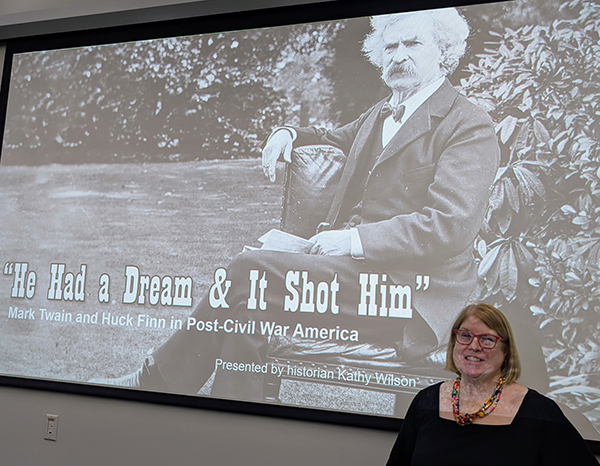Library hosts program on Mark Twain and Huck Finn

T-R PHOTO BY DORIE TAMMEN Historian Kathy Wilson gave a presentation titled “He Had a Dream and It Shot Him: Mark Twain and Huck Finn in Post-Civil War America” at the Marshalltown Public Library on Thursday.
Professional historian and educator Kathy Wilson presented a program on Thursday at the Marshalltown Public Library entitled, “Mark Twain and Huck Finn in a Post Civil War America.” Wilson received her BA in History from Bemidji State University in Minnesota and completed her MA at the University of York in England. She is a former PhD candidate at the University of Iowa and specializes in 18th and 19th-century British American cultural history.
Mark Twain was the pen name for Samuel Clemons. His novel “The Adventures of Huckleberry Finn” is one of America’s greatest literary works. It is one of his most popular books, but also his most controversial one. First published in 1884, today it often appears on banned book lists. Wilson’s intent in the program was to explore why the book was so controversial, both then and now.
The book tells the story of a teenaged Huck Finn, raised by an abusive father, who experiences adventure and danger floating down the Mississippi River with an escaped slave named Jim. Huck and Jim, each his own way, grapple with freedom and what it means to them, right versus wrong, and social conscience.
Victorian attitudes, the Civil War, and Twain’s own life experiences inspired the book. Twain lived from 1835 to 1910. Three major cultural changes influenced life in America during Twain’s lifetime.
The American Revolution from 1776 to 1783 brought about a new civic role for women, now tasked with raising children to be patriotic citizens of the new nation. Twain’s mother was a loving, tender-hearted mom to her seven children. He was remote and unemotional, and died unexpectedly, leaving the family destitute.
The Industrial Revolution, 1790 – 1820s, took production from the homefront to separate workplaces, with men leaving home to work, and women and children remaining at home and left out of the production process. Twain’s father was a storekeeper, lawyer, judge, and land speculator who dreamed of getting rich but never succeeded. His mother struggled for years to make ends meet. Three of her children died young.
The Second Great Awakening, a time of intense religious revival and evangelism from 1790 to 1830, prompted major social reform movements such as temperance, women’s suffrage, and abolitionism. Twain’s father once served on a jury that sentenced two alleged abolitionists to 12 years in prison.
These social and cultural changes altered male/female stereotypes and expectations and created a “cult of respectability.” Men were supposed to be strong, productive, self-made leaders, dominant and intellectually superior to women. Men were morally inferior to women, however. Women were supposed to be submissive and dependent, dedicated to family and home, and were intellectually inferior. They were, however, morally superior to men because of their attention to home and the family’s religious life.
Like gender expectations during this era, the political and economic climate was also clearly defined. Minorities –Native Americans, Mexicans, and enslaved people, especially — were “less than” white citizens and received only limited acceptance in society. The northern states were progressive, industrial, innovative, and anti-slavery. They viewed the southern states as backward and ignorant. Conversely, the southern states were conservative, traditional, agricultural, and pro-slavery, and viewed the north as corrupt and hypocritical.
Twain’s father owned one slave, but his uncle was a farmer with multiple slaves, and young Twain spent his summers on the farm, where he frequented the slave quarters and listened to the songs and stories of the slaves. He attended a private school and Sunday school until his father’s death in 1848. After that, everyone in the family had to focus on survival. His brothers got into newspaper publishing. His brother Orion Clemons published newspapers in Muscatine and Keokuk, Iowa, and Twain worked for him for a time.
At age 22 Twain decided he wanted to see the world and took a steamer to New Orleans to see the Amazon River but ended up convincing the captain to accept him as an apprentice. He became a licensed river boat pilot and worked up and down the Mississippi for a few years. (That is how he invented his pen name. “Mark twain” is a riverboat phrase related to water depth.) Later, he began writing stories and travel letters for newspapers while on a trip west with Orion and cruising overseas to Hawaii, Europe, and the Holy Land. He gained national attention as a humorist and satirist.
Twain married Olivia “Livy” Langdon in 1870. She was an intellectual, progressive woman from a progressive family in Elmira, New York. Elmira was a hotbed of reform and activism. Her parents were active in the Underground Railroad. Her mother was active in charitable work, and women’s social organizations, and she was a temperance supporter Twain and Livy had quite an interesting romance. He proposed within days of meeting her, but it took five more months and 180 daily letters from Twain before she accepted! The couple were well-matched, happy, and had four children. Sadly, three of them died young.
After the Civil War, previous social norms were forever changed. Women joined the work force with husbands off to war, and with 600,000 dead, they remained there after the war. Disabled veterans were dependent on women for care and support. Earlier gender roles became blurred as a result. In addition, an influx of free Black men into the northern states created competition for jobs.
This social upheaval and job competition fueled racism and discrimination in the north and the south. Stereotypes of minorities, including African, Mexican, and Native Americans, Irish, Italian, were common. Some minorities in the north had an even harder time finding employment than Black men. The South reinforced segregation and enacted Jim Crow Laws. Racism became a plank in political parties.
The idea of the “Lost Cause,” based on the belief that the South had fought for a just cause–states’ rights and defense of the Constitution–gained widespread acceptance both in the south and the north. Believers supported a strict patriarchal and social hierarchy with Black people deferential to whites, poor whites deferential to wealthier whites, and women deferential to men. This attitude was passed on from one generation to the next, and desegregation was actively resisted for generations.
Twain continued evolving and maturing as an author during this time. He became involved in publishing, invested in new typesetting equipment, traveled, and spent time on the Mississippi. Things did not go well, however, and by 1890, he suffered a financial crisis. His publishing company filed bankruptcy in 1894. Despite this, Twain continued to write, began a 140-stop lecture tour, traveled the world for several years, and returned to the States in 1900, to great acclaim.
Livy died in 1904 while the family was in Italy. Twain died peacefully in his bed in 1910 from heart disease. He had written twenty-eight books and numerous short stories. “The Adventures of Huckleberry Finn” was his greatest accomplishment. “All modern American literature comes from one book by Mark Twain called “Huckleberry Finn” …American writing comes from that. There was nothing before. There has been nothing as good since.” — Ernest Hemingway.
Critics gave the book mixed reviews, some giving it high praise, and others calling it “rubbish.” So why was the book so controversial in 1885, and why does it remain so even today?
It was the first truly American novel and addresses the greatest contradiction in American history: the existence of slavery and racial prejudice in a country dedicated to liberty and equality. The narrator, Huck Finn, speaks in dialect rather than standard, “proper” English. It includes the infamous and insulting “n-word.” It dismisses religion as immaterial to everyday life when one is homeless and hungry. Older women are depicted as controlling and repressive. It tosses out all earlier American standards of gender, morals, behavior, speech, and relationships. It reinforces yet also challenges stereotypes. Perhaps Twain struck a nerve or two?



